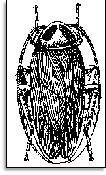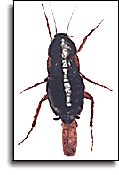COCKROACHES
|
|
GERMAN COCKROACH |
| DISTRIBUTION |
The german cockroach is worldwide in distribution. It is the most prevalent
species in and around homes, apartments, super markets, food processing
plants and restaurants. Ships especially cruise ships naval vessels, also
can be heavily infested. |
| DESCRIPTION |
The german cockroach is about 5/8 inch - 16 mm in length, brown in color,
with two dark longitudinal streaks on the pronotum. This breeds throughout the
year indoors, but favors a humid environment and an average temperature
of approximately 70°F-21°C. Female cockroaches carry their egg capsules
until they are ready to hatch. The number of eggs in a capsule is usually
between 30 and 40.
two dark longitudinal streaks on the pronotum. This breeds throughout the
year indoors, but favors a humid environment and an average temperature
of approximately 70°F-21°C. Female cockroaches carry their egg capsules
until they are ready to hatch. The number of eggs in a capsule is usually
between 30 and 40.
|
|
AMERICAN COCKROACH |
| DISTRIBUTION |
 The
species is known as cosmopolitan, but it is not found in northern areas
as other species. This cockroach is commonly found in sewers and basements,
particularly around pipes. The
species is known as cosmopolitan, but it is not found in northern areas
as other species. This cockroach is commonly found in sewers and basements,
particularly around pipes. |
| DESCRIPTION |
It is the largest of the house infesting cockroaches being 1 ½ inches
- 38mm long with fully developed reddish brown wings and light marking on
thorax. The eggs in egg capsule are variable. The first few capsules by
a female may contain a full complement of 16 eggs. However, the average
number of young to emerge from 511 fertile was 13,6. |
|
OTHER COCKROACH SPECIES
ORIENTAL - SMOKYBROWN - AUSTRALIAN - SURINAM |
| HABITS |
They are abound near hot water pipes, moist, kitchen sinks, behind stores
and refrigerators, under kitchen and dining room tables, in cracks or crevices
big enough for them to hide, and inside drains. They are active at night
and when discovered, scurry quickly to hiding.
refrigerators, under kitchen and dining room tables, in cracks or crevices
big enough for them to hide, and inside drains. They are active at night
and when discovered, scurry quickly to hiding. |
| POTENTIAL HAZARDS |
Because cockroaches are so closely associated with humans and commonly
feed on decaying food, crumbs or scraps and frequent unsanitary areas such
as sewage system and septic tank, their presence leads to suspicion of a
threat to human health. Pathogenic organisms have been isolated from cockroaches
collected in domestic or peridomestic environment. (Diarrhea - gastroenteritis
- shigella - disentery - pneumonia - respiratory infection - food poisoning) |
| PREVENTION |
Cockroach need food, water and harborage in order to survive. By reducing
these three factors the population of pests can be reduced. Fixing plumbing
leaks.
Removing harborage and clutter.
Sealing areas where cockroaches enter structures.
Construction changes to eliminate hiding areas.
Proper sanitation to decrease source food and water. |
| CONTROL |
Improved sanitation alone has never eliminated well established infestation
of mult-diet species such as german cockroaches. Residual insecticides application
should be made in cracks and crevices, on their harborage, barrier treatment
indoors - outdoors, in sewage and other potential breeding areas. Bait poison
and glue pherormon traps are available but less effective in heavy infestation. |
 two dark longitudinal streaks on the pronotum. This breeds throughout the
year indoors, but favors a humid environment and an average temperature
of approximately 70°F-21°C. Female cockroaches carry their egg capsules
until they are ready to hatch. The number of eggs in a capsule is usually
between 30 and 40.
two dark longitudinal streaks on the pronotum. This breeds throughout the
year indoors, but favors a humid environment and an average temperature
of approximately 70°F-21°C. Female cockroaches carry their egg capsules
until they are ready to hatch. The number of eggs in a capsule is usually
between 30 and 40. The
species is known as cosmopolitan, but it is not found in northern areas
as other species. This cockroach is commonly found in sewers and basements,
particularly around pipes.
The
species is known as cosmopolitan, but it is not found in northern areas
as other species. This cockroach is commonly found in sewers and basements,
particularly around pipes. refrigerators, under kitchen and dining room tables, in cracks or crevices
big enough for them to hide, and inside drains. They are active at night
and when discovered, scurry quickly to hiding.
refrigerators, under kitchen and dining room tables, in cracks or crevices
big enough for them to hide, and inside drains. They are active at night
and when discovered, scurry quickly to hiding.